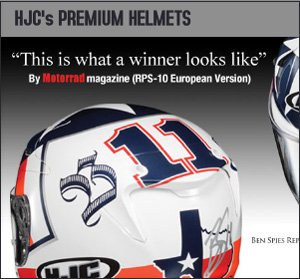Motorcycle Helmet Tips
Below we have provided you with a list of motorcycle helmet tips for choosing a helmet that perfectly suits your head and your riding experience:
1. Try on motorcycle helmets for at least five minutes to detect bothersome areas. Look in the mirror for symmetry, to ensure that the helmet rests just above your brows and to see if any red marks remain after taking off the helmet.
2. After you have purchased your helmet, try not to store in a high or unsteady place where it could come crashing to the ground (such as the motorcycle saddle or side of the mirror. Don't risk scratching or busting an expensive motorcycle helmet.
3. Observe motorcycle helmet safety standards. If a cheap motorcycle helmet has not been Snell certified, for example, or is not a DOT approved motorcycle helmet, your insurance company may refuse to provide accident coverage.
4. Make sure your helmet has undergone anti-scratch and anti-fog treatment. In addition, be sure the visor doesn't touch the helmet outer shell resulting in scratches or fuzzy vision areas on your visor.
5. A lighter helmet may be more comfortable than its heavier counterpart, but is perhaps less equipped to ensure motorcycle safety.
6. Consider your chinstrap while checking your motorcycle helmet--the strap should not be too long and should be able to be tucked away so as not to hit your chin repeatedly.
7. Poor ventilation systems are chief causes of noisy helmets. The more aerodynamic the helmet and the better the vents, the less noise there will be.
8. A motorcycle helmet's comfort liner can mold a bit to the shape of your head so the helmet typically becomes more comfortable over time and use. Be sure, however, that you start with a good fit.
9. Inquire about the motorcycle helmet safety standards the motorcycle helmet manufacturer has met. A cheap motorcycle helmet may eschew certain safety testing standards. Moreover, always observe motorcycle helmet law by state, particularly if you are a young rider.


